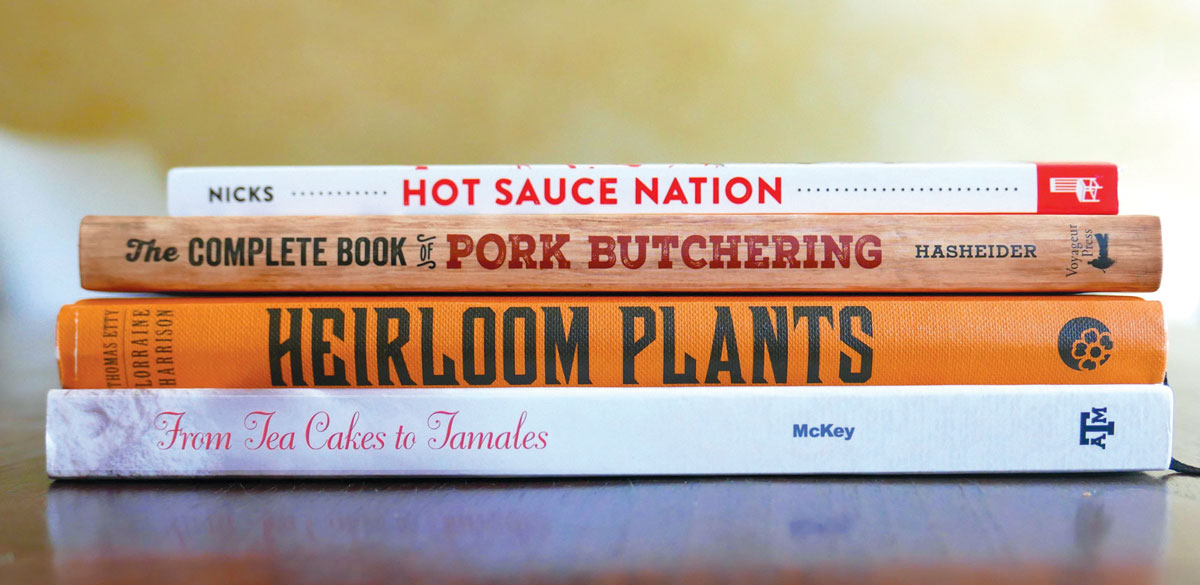Covers to Wrap, Titles to String
Finding the perfect gift can be a challenge, but the literary world is your oyster, replete with pearls. Make your list, check it twice and start shopping for your favorite foodie today. (Even if it’s you. Heck, especially if it’s you.)
There is a lot to love about Heirloom Plants: A Complete Compendium of Heritage Vegetables, Fruits, Herbs and Flowers by Thomas Etty and Lorraine Harrison (Ball Publishing, $29.99), from the Cook’s Illustrated vibe of the layout and illustrations to its vintage-y orange hardcover design and sewn-into-the-binding cloth bookmark. Heirloom Plants is beautiful enough to earn a spot on the bookshelf on aesthetics alone, but the material between the covers delivers in spades.
Authors Etty and Harrison pack a lot of information into 224 pages, including seed, herb and flower directories, along with cultivation tips, a cutting tool guide for gardeners and (of course) a history of heirloom plants. They use the tagline “Growing the past, saving the future” to capture both the historical aspect of heirloom plants and their importance in terms of biodiversity. Publisher’s Weekly described Heirloom Plants as an “encyclopedic delineation of ‘directories’” that are perfect for the gardener “interested in preserving heirloom cultivars and turning a green-thumb hobby into an all-out mission.”
Perfect for: Your “Good Eats”-loving friend whose favorite episodes feature nutritional anthropologist Deborah Duchon, or a master gardener aspirant.
Goes on the shelf next to: The Drunken Botanist by Amy Stewart
Open to: Page 94, to learn about Colonel Robert Johnson, brave tomato ambassador to the New World
Turning from fruits to flesh, The Complete Book of Pork: Butchering, Curing, Sausage Making and Cooking by Philip Hasheider (Voyageur Press, $24.99) truly begins at the beginning—Chapter One is titled “Raising Your Own Pig,” Chapter Two “Butchering at Home.”
It only takes Hasheider about 200 pages to break down pork from your backyard pen to your plate, but the journey is packed with important information and excellent photographs. The attention to detail is apparent throughout, particularly the wonderful charts scattered among the pages; Hasheider provides everything from nutritional breakdowns for feeding pigs to extensive breakdowns of pork cooking timetables and temperatures.
The author posits an interesting argument: that as the “world’s favorite meat,” pork—which is healthy, and versatile—is not used to its potential by the average home cook. “A single butchered market hog can produce 371 servings of pork,” according to the back cover, and curious home cooks can and should take advantage of pork’s potential by taking on challenges like sausage-making and charcuterie.
Perfect for: Anyone craving to try that whole hog from a local farmer
Goes on the shelf next to: The Complete Nose to Tail by Fergus Henderson
Open to: Page 75, to see Queen Elizabeth II inspecting livestock, plus cool tips on pigs’ brains
Rooted in nostalgia and tradition, From Tea Cakes to Tamales: Third-Generation Texan Recipes by Nola McKey (Texas A&M University Press, $29.99) brings third-generation recipes to life through short stories and photos of the recipes’ originators. More than 100 people contributed recipes for McKey’s book, representing a variety of ethnic and cultural backgrounds.
Three-time James Beard Award winner Robb Walsh raved about McKey’s work, calling the book “magnificent” and “a Proustian endeavor” that succeeds in creating a “deeply personal album of Texas families from many cultures and an incredibly valuable documentation of Texas food history.” A recipe for Czech Sauerkraut (p. 106) lives next to a recipe for traditional Southern spoonbread, and later in the book, French and Scottish puddings go head-to-head.
When McKey tackles tamales (p. 47) she lays out the work in three easy-to-follow steps, including make-ahead and preparation steps to help the novice get organized for this labor-intensive task. The one-and-only Sylvia Casares, of Sylvia’s Enchilada Kitchen, contributed this recipe along with the tamale-making instructions handed down from her grandmother, “Mama Grande.” Don’t get so caught up in recipes that you miss Chapter 3: “Preserving Heirloom Recipes,” which offers excellent tips for preserving your own family favorites.
Perfect for: Anyone who loves Texas and/ or tradition
Goes on the shelf next to: Your family recipe book
Open to: Page 105, for Lillian Piazza Cappello’s recipe for hot antipasto, which calls for the best-quality olive oil you can find; Texas Hill Country Olive Oil, anyone?
STOCKING STUFFER
In Hot Sauce Nation: America’s Burning Obsession (Chicago Review Press, $17.99), author Denver Nicks gives readers a unique look at how chili peppers and hot sauce gained widespread popularity in the United States. By examining the history, science and economics of the chili pepper, Nicks offers a fun and factual road map from the chili’s likely original origins in Bolivia all the way to the U.S., via generations of migrant workers.
This 220-page paperback is the perfect stocking stuffer for your hot-sauce-loving friends and family members. Nicks’ wit makes this more than a simple culinary history of the chili pepper; he delivers the history of hot sauce with deft humor that will keep you laughing, and turning pages.
Part culinary history, part travelogue, Hot Sauce Nation takes Nicks to places like Oaxaca, Mexico; Houston, Texas; and Avery Island, Louisiana, and the living history of hot sauce is revealed through these excursions—colorful characters definitely included.
Whether he’s covering the complexities of capsaicin or taking us through historic trade routes, Nicks’ prose is fast-paced and engaging. If you’re burning for a literary adventure, Hot Sauce Nation will light you on fire.






